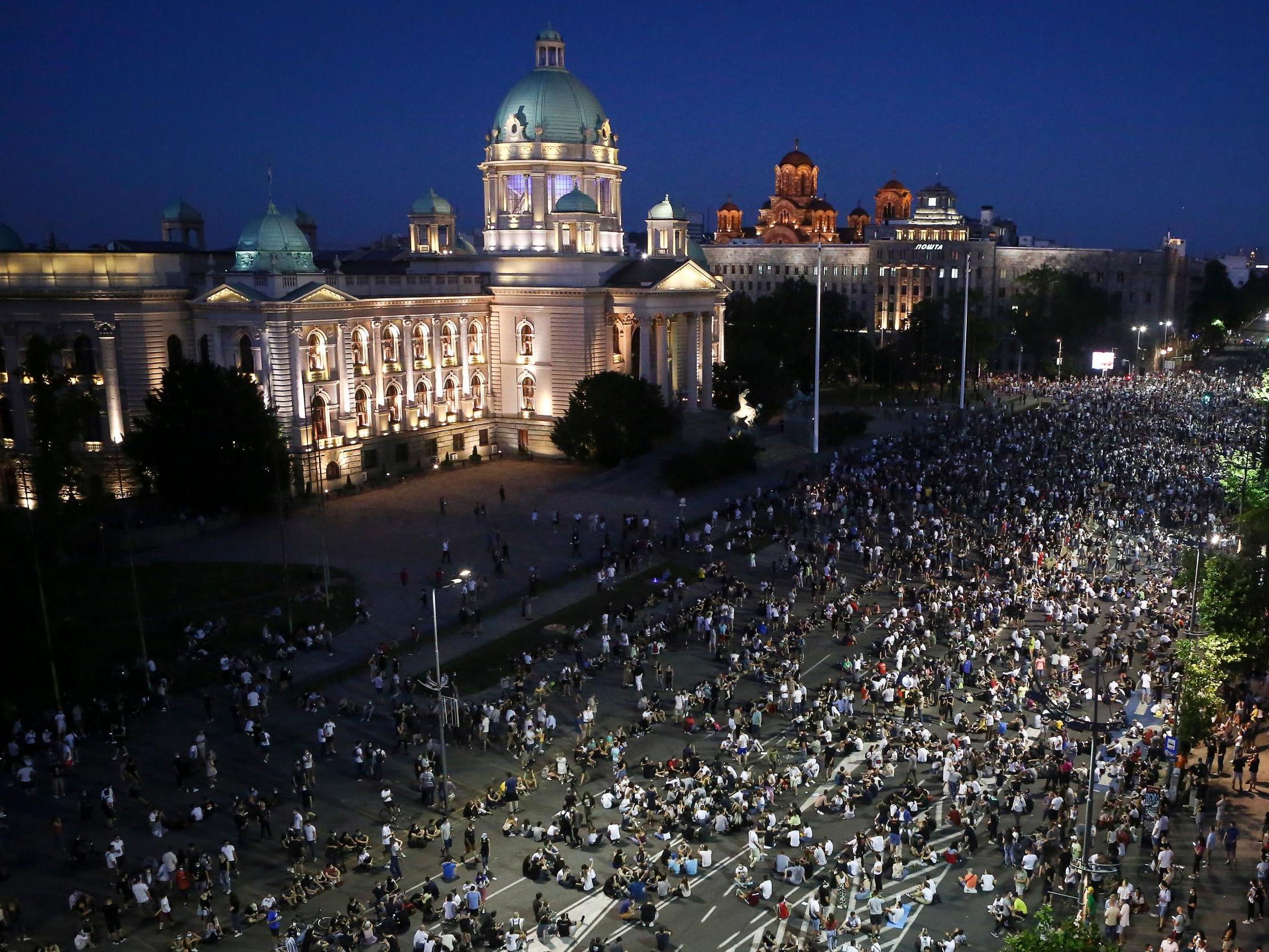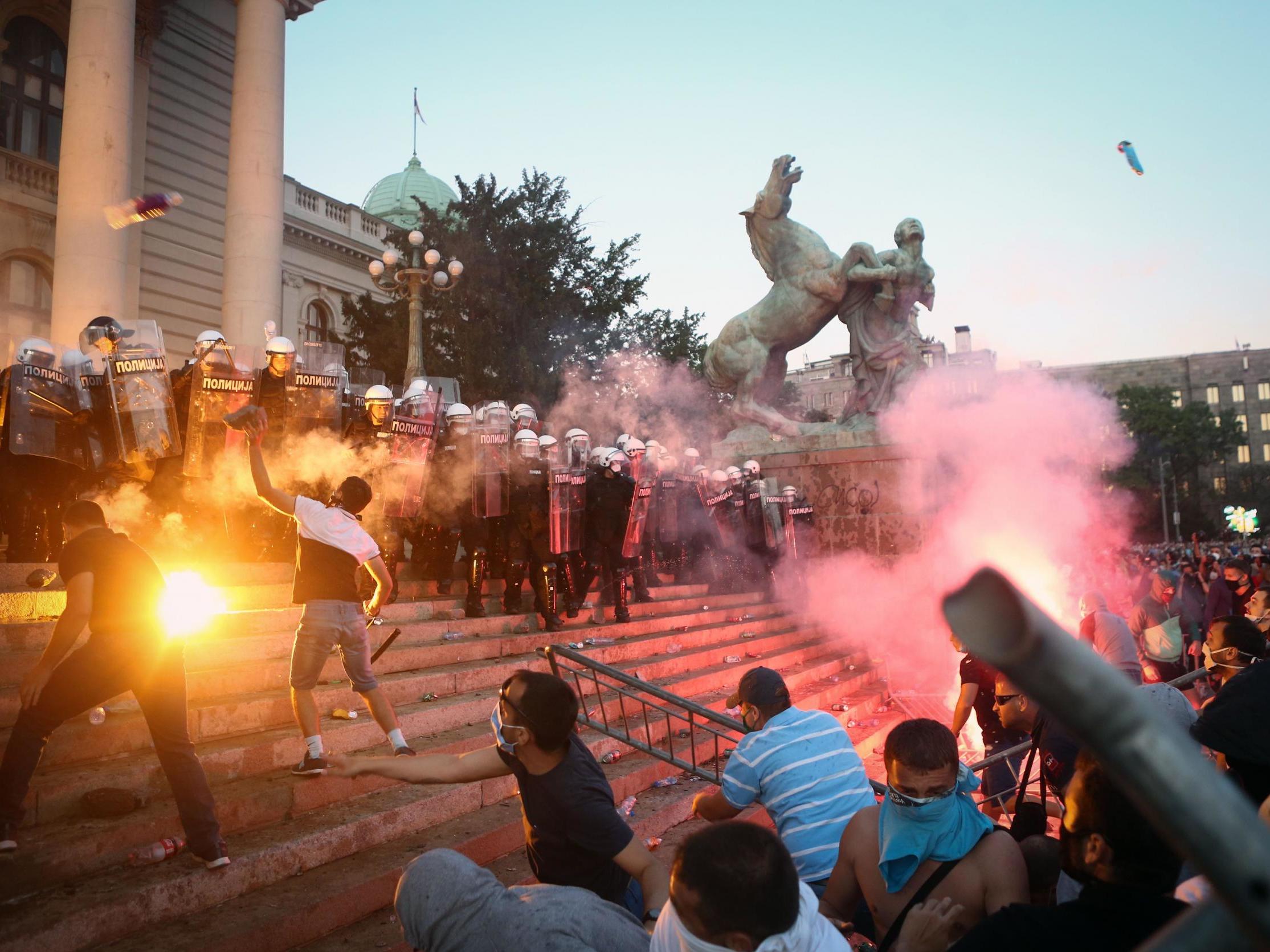Serbian protesters defy ban and unite in streets after two nights of violence
Demonstrators largely resist nationalists’ provocations, but journalists attacked by suspected smear groups

Your support helps us to tell the story
From reproductive rights to climate change to Big Tech, The Independent is on the ground when the story is developing. Whether it's investigating the financials of Elon Musk's pro-Trump PAC or producing our latest documentary, 'The A Word', which shines a light on the American women fighting for reproductive rights, we know how important it is to parse out the facts from the messaging.
At such a critical moment in US history, we need reporters on the ground. Your donation allows us to keep sending journalists to speak to both sides of the story.
The Independent is trusted by Americans across the entire political spectrum. And unlike many other quality news outlets, we choose not to lock Americans out of our reporting and analysis with paywalls. We believe quality journalism should be available to everyone, paid for by those who can afford it.
Your support makes all the difference.Seated protesters have filled streets across Serbia in a powerful display of discontent, hours after authorities banned gatherings of more than 10 people in response to two nights of violent skirmishes between police, far-right agitators and those protesting the government’s handling of the coronavirus crisis.
Thousands defied the ban to stage a “sit-in” in front of Serbia’s parliament complex, which protesters had stormed two nights earlier, with similar demonstrations also taking place peacefully in Novi Sad, Nis, and many other cities.
The unrest started on Tuesday evening after president Aleksandar Vucic said further lockdown measures would likely be reimposed due to rising coronavirus cases and full hospitals, particularly in Belgrade, sparking furious clashes the president described as the country’s most brutal political violence in years.
Mr Vucic – whose populist right-wing Serbian Progressive Party retained power in a controversial and partially boycotted election on 22 June – backed down from his plans to impose a curfew, instead issuing the ban on gatherings, largely viewed as an attempt to criminalise the mass protests.
While the violence seen on the two nights prior – in which dozens of citizens and police were injured – was largely discontinued on Thursday, there were reports of more minor clashes between demonstrators and nationalist groups towards the end of the night, and two journalists were attacked.
Famed television presenter Ivan Ivanovic tweeted an image of a digital camera covered in blood, captioned “my reporter”, with some local media outlets reporting that projectiles had been thrown at his crew, one of whom suffered a broken nose.
Vojislav Milovancevic, a journalist with Nova, required medical treatment. He reported being approached by “a group of guys with hoods”, telling his colleagues: “One of them, when he saw me filming, ran towards me and asked ‘what are you filming’.
“I told him I was a journalist and then he hit me, I think with a knuckle-duster. He swung twice and the third time he hit me in the back of the head and bled my head.”
There were reports of at least two other journalists being confronted during the demonstrations and accused of lying. Mistrust of the media is high in Serbia amid alleged collusion between press and government, and the demonisation of critical outlets.
In May, Reporters Without Borders warned: “After six years under the leadership of Aleksandar Vucic ... Serbia has become a country where it is often dangerous to be a journalist and where fake news is gaining in visibility and popularity at an alarming rate.”
Many protesters wore white T-shirts bearing the words “Sit Down, Don’t Be Set Up” — referring to widespread claims that the violence the previous nights was staged by groups close to the authorities to smear the opposition groups’ image.
Many offered the demonstrations’ vastly peaceful nature as proof that Thursday’s protests represented a true gathering of the people, and that the previous nights had been hijacked by those with ulterior motives.
Social media footage suggested many seated protesters resisted attempts by hooded agitators to provoke them.
“This is how the protest should really look like, without their mad dogs present,” said one of the main opposition leaders, Dragan Djilas.
Mistrust of the autocratic president and his government has been exacerbated by the pandemic, with protesters accusing authorities of lifting the lockdown too soon, granting freedoms such as sporting events and nightclubs ahead of the election, and of a lack of transparency over the scale of infection.
Some protesters carried banners reading: “Aleksandar “Vucic is more dangerous than Covid!”
According to the government, Serbia has recorded some 17,300 cases and suffered 352 deaths.
“The health system in Belgrade is close to breaking up,” prime minister Ana Brnabic said. “That is why I can’t understand what we saw last night and the night before.”
Both the US embassy and Amnesty International also expressed concern at the violence – “including what appeared to us to be coordinated attacks on police seemingly intended to provoke overreactions, as well as what appeared to the use of excessive force by police”, the US embassy said.

Over the previous two evenings, rock-throwing demonstrators fought running battles with special police forces, who used tear gas, armoured vehicles and horses to disperse them.
Serbia’s police chief, Vladimir Rebic, said 118 police officers were injured and 153 protesters were detained, adding: “Such violence is inadmissible and police will use all means to stop it.”
Both protests started peacefully before far-right nationalist groups started hurling objects at police.
Amnesty accused the police of applying “heavy-handed measures”, with the group’s Balkans researcher Jelena Sesar saying: “Images of Serbian police firing tear gas and stun grenades indiscriminately into the crowd, and of protesters and bystanders being charged by mounted police and beaten by police in riot gear, raise serious concerns.”
Videos on social media appeared to show police severely beating up protesters. In one, a protester was seen being hit and kicked by several officers and dumped on the sidewalk, seemingly unconscious. The authenticity of the videos could not be independently verified.
In an Instagram post on Thursday — from inside the plane taking him on an official visit to France — Mr Vucic said the state will curb unrest, and urged his followers not to confront violent demonstrators.
“I promised that we will know how to preserve peace and stability despite criminal hooligan violent attacks that have shocked us all,” he said.
Mr Vucic has accused foreign intelligence services of being behind the unrest and has described the protests as “political” and aimed at weakening Serbia in its talks with Kosovo, whose 2008 declaration of independence Belgrade does not recognise.
Although Mr Vucic stopped short of identifying the alleged foreign spy agencies, tabloids under his control accused pro-Russia far-right groups of fuelling the violence. The Russian ambassador to Serbia on Thursday vehemently denied accusations that Moscow was behind the unrest.
Additional reporting by AP
Join our commenting forum
Join thought-provoking conversations, follow other Independent readers and see their replies
Comments